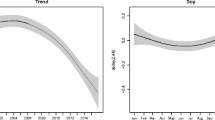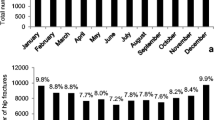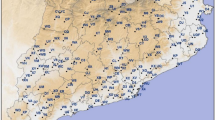Abstract
Summary
Osteoporotic hip fractures in 4344 patients were more common during winter. Lower temperatures were associated with higher rates of fracture only in those not vaccinated for influenza. Influenza outbreaks increased the risk of hip fractures. Further studies are needed to assess whether influenza vaccination can prevent hip fractures.
Introduction
Winter seasonality of osteoporotic hip fracture incidence has been demonstrated, yet the explanation for the association is lacking. We hypothesize that the seasonality of osteoporotic hip fracture can be explained by an association between hip fractures and seasonal influenza outbreaks.
Methods
This retrospective cohort study included all patients admitted to Soroka University Medical Center with a diagnosis of osteoporotic hip fracture (ICD-9 code 820) between the years 2001 and 2013. Patients with malignancies, trauma, and age under 50 were excluded. In a time series analysis, we examined the association between hip fracture incidence and seasonality adjusted for meteorological factors, and population rates of influenza infection and vaccination using Poisson models.
Results
Four thousand three hundred forty-four patients with a hip fracture were included (69% females, mean age 78). Daily fracture rates were significantly higher in winter (1.1 fractures/day) compared to summer, fall, and spring (0.79, 0.90, and 0.91; p < 0.001). In analysis adjusted for seasons and spline function of time, temperatures were associated with hip fractures risk only in those not vaccinated for influenza (n = 2939, for every decrease of 5 °C, RR 1.08, CI 1.02–1.16; p < 0.05). In subgroup analysis during the years with weekly data on national influenza rates (2010–2013), the risk for hip fracture, adjusted for seasons and temperature, was 1.26 2 weeks following a week with high infection burden (CI 1.05;1.51 p = 0.01), while the temperature was not significantly associated with the fracture risk.
Conclusions
Under dry and warm desert climate, winter hip fracture incidence increase might be associated with influenza infection, and this effect can be negated by influenza vaccination.
Similar content being viewed by others
References
Bentler SE, Liu L, Obrizan M et al (2009) The aftermath of hip fracture: discharge placement, functional status change, and mortality. Am J Epidemiol 170:1290–1299
Koren L, Barak A, Norman D, Sachs O, Peled E (2014) Effect of seasonality, weather and holidays on the incidence of proximal hip fracture. Isr Med Assoc J 16:299–302
Jacobsen SJ, Sargent DJ, Atkinson EJ, O’Fallon WM, Melton LJ 3rd (1995) Population-based study of the contribution of weather to hip fracture seasonality. Am J Epidemiol 141:79–83
Lin HC, Xiraxagar S (2006) Seasonality of hip fractures and estimates of season-attributable effects: a multivariate ARIMA analysis of population-based data. Osteoporosis international: a journal established as result of cooperation between the European Foundation for Osteoporosis and the National Osteoporosis Foundation of the USA 17:795–806
Mirchandani S, Aharonoff GB, Hiebert R, Capla EL, Zuckerman JD, Koval KJ (2005) The effects of weather and seasonality on hip fracture incidence in older adults. Orthopedics 28:149–155
Douglas S, Bunyan A, Chiu KH, Twaddle B, Maffulli N (2000) Seasonal variation of hip fracture at three latitudes. Injury 31:11–19
Tenias JM, Estarlich M, Fuentes-Leonarte V, Iniguez C, Ballester F (2009) Short-term relationship between meteorological variables and hip fractures: an analysis carried out in a health area of the Autonomous Region of Valencia, Spain (1996-2005). Bone 45:794–798
Chesser TJ, Howlett I, Ward AJ, Pounsford JC (2002) The influence of outside temperature and season on the incidence of hip fractures in patients over the age of 65. Age Ageing 31:343–348
Levy AR, Bensimon DR, Mayo NE, Leighton HG (1998) Inclement weather and the risk of hip fracture. Epidemiology (Cambridge, Mass) 9:172–177
Bulajic-Kopjar M (2000) Seasonal variations in incidence of fractures among elderly people. Inj Prev J Int Soc Child Adolesc Inj Prev 6:16–19
Bischoff-Ferrari HA, Orav JE, Barrett JA, Baron JA (2007) Effect of seasonality and weather on fracture risk in individuals 65 years and older. Osteoporosis international: a journal established as result of cooperation between the European Foundation for Osteoporosis and the National Osteoporosis Foundation of the USA 18:1225–1233
Pedrazzoni M, Alfano FS, Malvi C, Ostanello F, Passeri M (1993) Seasonal variation in the incidence of hip fractures in Emilia-Romagna and Parma. Bone 14(Suppl 1):S57–S63
Crawford JR, Parker MJ (2003) Seasonal variation of proximal femoral fractures in the United Kingdom. Injury 34:223–225
Inderjeeth CA, Barrett T, Al-Lahham Y, Mulford J, Nicklason F, Reberger C (2002) Seasonal variation, hip fracture and vitamin D levels in Southern Tasmania. N Z Med J 115:183–185
Costa AG, Wyman A, Siris ES et al (2013) When, where and how osteoporosis-associated fractures occur: an analysis from the Global Longitudinal Study of Osteoporosis in Women (GLOW). PLoS One 8:e83306
Gronskag AB, Forsmo S, Romundstad P, Langhammer A, Schei B (2010) Incidence and seasonal variation in hip fracture incidence among elderly women in Norway. HUNT Study Bone 46:1294–1298
Lofthus CM, Osnes EK, Falch JA, Kaastad TS, Kristiansen IS, Nordsletten L, Stensvold I, Meyer HE (2001) Epidemiology of hip fractures in Oslo, Norway. Bone 29:413–418
Bastow MD, Rawlings J, Allison SP (1983) Undernutrition, hypothermia, and injury in elderly women with fractured femur: an injury response to altered metabolism? Lancet (London, England) 1:143–146
Webb AR, Kline L, Holick MF (1988) Influence of season and latitude on the cutaneous synthesis of vitamin D3: exposure to winter sunlight in Boston and Edmonton will not promote vitamin D3 synthesis in human skin. J Clin Endocrinol Metab 67:373–378
Cauley JA, Lacroix AZ, Wu L et al (2008) Serum 25-hydroxyvitamin D concentrations and risk for hip fractures. Ann Intern Med 149:242–250
Barnes M, Heywood AE, Mahimbo A, Rahman B, Newall AT, Macintyre CR (2015) Acute myocardial infarction and influenza: a meta-analysis of case-control studies. Heart 101:1738–1747
Clar C, Oseni Z, Flowers N, Keshtkar-Jahromi M, Rees K (2015) Influenza vaccines for preventing cardiovascular disease. Cochrane Database Syst Rev 5:Cd005050
Grau AJ, Urbanek C, Palm F (2010) Common infections and the risk of stroke. Nat Rev Neurol 6:681–694
Alpert P, Osetinsky I, Ziv B, Shafir H (2004) A new seasons definition based on classified daily synoptic systems: an example for the eastern Mediterranean. Int J Climatol 24:1013
Roman Ortiz C, Tenias JM, Estarlich M, Ballester F (2015) Systematic review of the association between climate and hip fractures. Int J Biometeorol 59:1511–1522
Hindiyeh M, Goulding C, Morgan H et al (2000) Evaluation of BioStar FLU OIA assay for rapid detection of influenza A and B viruses in respiratory specimens. J Clin Virol 17:119–126
Hindiyeh M, Ram D, Mandelboim M et al (2010) Rapid detection of influenza A pandemic (H1N1) 2009 virus neuraminidase resistance mutation H275Y by real-time reverse transcriptase PCR. J Clin Microbiol 48:1884–1887
Itoh Y, Shinya K, Kiso M et al (2009) In vitro and in vivo characterization of new swine-origin H1N1 influenza viruses. Nature 460:1021–1025
Collins KJ, Easton JC, Belfield-Smith H, Exton-Smith AN, Pluck RA (1985) Effects of age on body temperature and blood pressure in cold environments. Clinical Science (London, England: 1979) 69:465–470
Riley MW, Cochran DJ (1984) Dexterity performance and reduced ambient temperature. Hum Factors 26:207–214
Campbell AJ, Spears GF, Borrie MJ, Fitzgerald JL (1988) Falls, elderly women and the cold. Gerontology 34:205–208
Bartley JM, Pan SJ, Keilich SR, Hopkins JW, Al-Naggar IM, Kuchel GA, Haynes L (2016) Aging augments the impact of influenza respiratory tract infection on mobility impairments, muscle-localized inflammation, and muscle atrophy. Aging
Gozalo PL, Pop-Vicas A, Feng Z, Gravenstein S, Mor V (2012) Effect of influenza on functional decline. J Am Geriatr Soc 60:1260–1267
Ikematsu H, Takeuchi Y, Rosenlund M, Kawai N, Shimamura R, Hirata M, Iwaki N (2012) The post-infection outcomes of influenza and acute respiratory infection in patients above 50 years of age in Japan: an observational study. Influenza Other Respir Viruses 6:211–217
Author information
Authors and Affiliations
Corresponding author
Ethics declarations
The study was approved by the Institutional Review Board.
Conflicts of interest
None.
Electronic supplementary material
ESM 1
(DOCX 25 kb)
Rights and permissions
About this article
Cite this article
Fraenkel, M., Yitshak-Sade, M., Beacher, L. et al. Is the association between hip fractures and seasonality modified by influenza vaccination? An ecological study. Osteoporos Int 28, 2611–2617 (2017). https://doi.org/10.1007/s00198-017-4077-1
Received:
Accepted:
Published:
Issue Date:
DOI: https://doi.org/10.1007/s00198-017-4077-1




